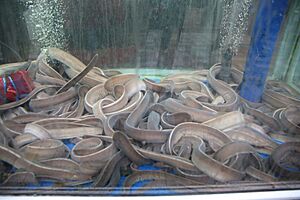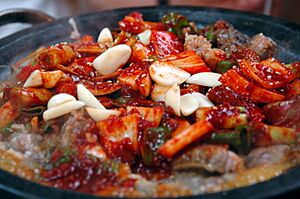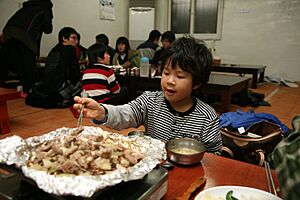Inshore hagfish facts for kids
Quick facts for kids Inshore hagfish |
|
|---|---|
 |
|
| Inshore hagfish at the market in Busan | |
| Conservation status | |
| Scientific classification | |
| Genus: |
Eptatretus
|
| Species: |
burgeri
|
| Synonyms | |
|
|
The inshore hagfish (Eptatretus burgeri) is a unique type of fish found in the Northwest Pacific Ocean. You can find it in places like the Sea of Japan, all along eastern Japan, and near Taiwan. This hagfish has six pairs of gill pouches, which are like openings for it to breathe.
These hagfish usually live in the shallow parts of the ocean, close to the shore. They often bury themselves in the soft mud at the bottom of the sea. When it's time to have babies, they move to deeper waters to lay their eggs. The inshore hagfish is special because it's the only hagfish that has a regular breeding season each year.
Scientists don't know a lot about how hagfish reproduce. It's hard to find their eggs or young ones to study in the wild. However, scientists have been able to breed Eptatretus burgeri in labs, which helps them learn more.
People in Korea use the skin of this hagfish to make something called "eel skin." This material is then sold all over the world.
Inshore Hagfish as Food
Most people around the world don't usually eat hagfish. But the inshore hagfish is different! It's a popular food in the Korean Peninsula and among Koreans living in Japan. Some people in Japan also enjoy it as a special local dish, especially in areas like Nagasaki and Niigata.
This hagfish has different names depending on the language:
- In Mandarin Chinese, it's called bùshì nián mángmán (布氏黏盲鰻) or púshì nián mángmán (蒲氏黏盲鰻).
- In Korean, it's known as kkomjangeo (꼼장어) or meokjangeo (먹장어).
- In Japanese, it's called nuta-unagi (ヌタウナギ).
Slime Production
Just like all hagfish, the inshore hagfish can produce a lot of slime when it feels scared or bothered. To get this slime, people sometimes put a live hagfish into a container and gently tap the container with a stick. This makes the hagfish release its special slime.




